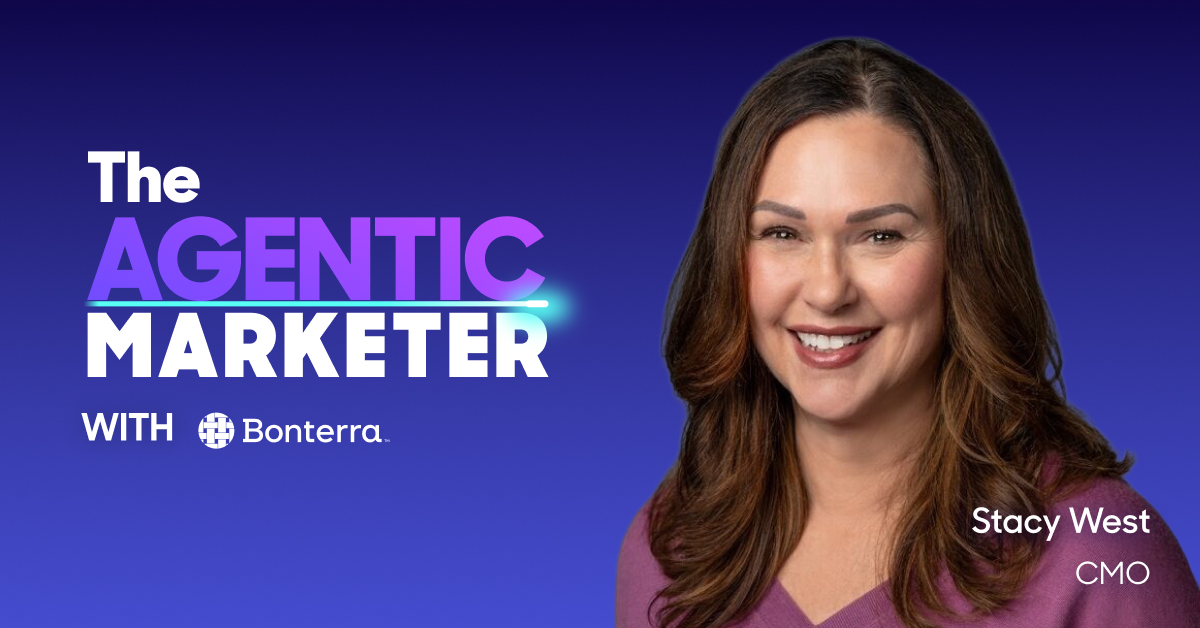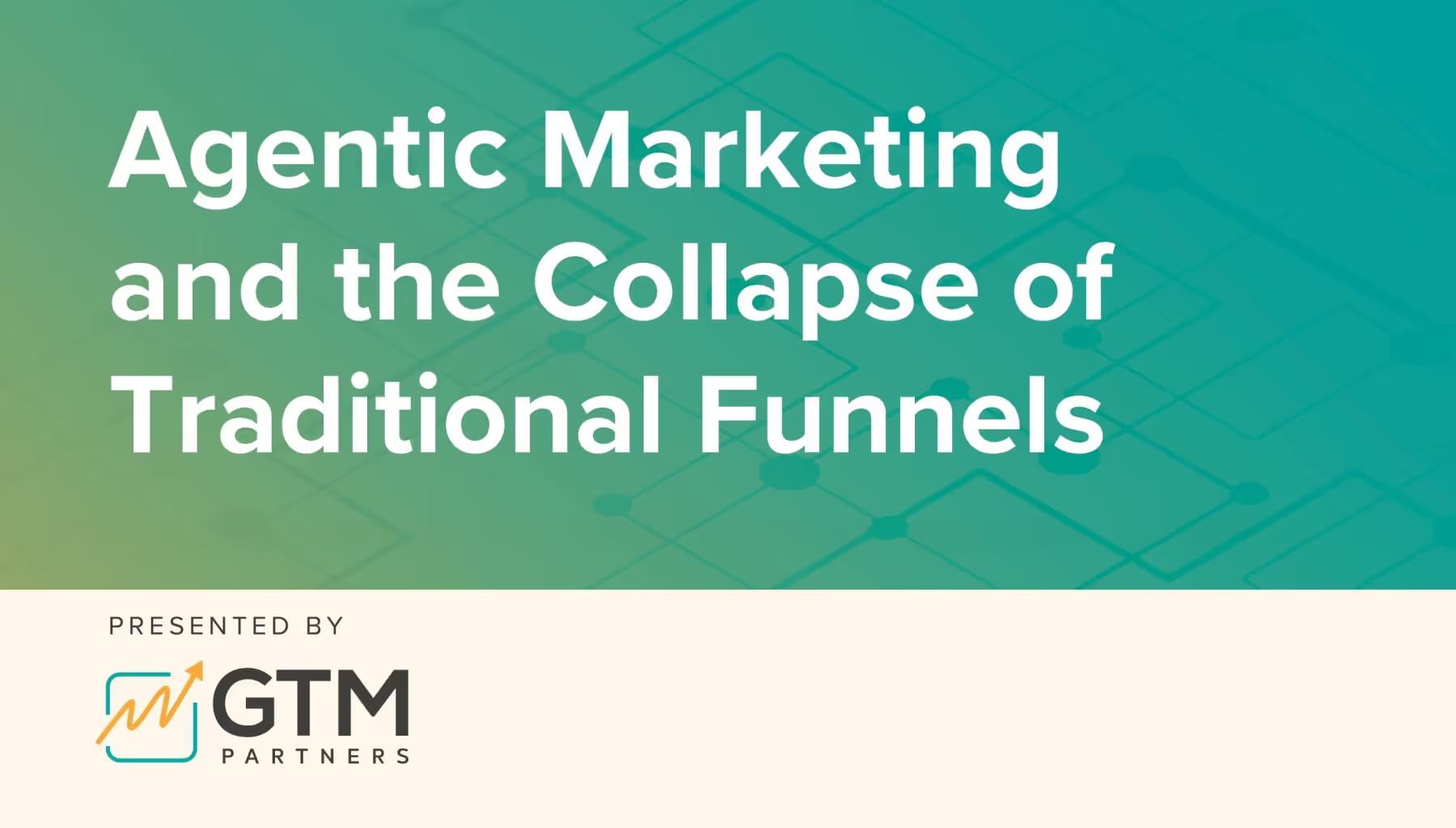This episode of The Agentic Marketer features Christina Scarmeas, CMO at Mogli, the Salesforce-native SMS platform trusted by nonprofits, universities, and pro sports teams around the world.
Christina shares how her team brought on “Taylor,” their AI SDR agent, to fuel pipeline and give buyers a better experience on the website. She walks through what it takes to operationalize agentic marketing, align humans and AI, and prove real revenue impact fast. In just 60 days, Mogli increased pipeline by 44%.
Key Takeaways:
- AI SDR agents are teammates, not replacements: Christina explains how Mogli positioned Taylor as a partner to help SDRs focus on high-value work.
- Your website is the front door: Learn why Mogli launched their AI SDR agent on their site to capture high-intent visitors 24/7.
- Change management is everything: Early buy-in from sales, marketing, and leadership ensured adoption across the org.
- Framework + data = success: Weekly reviews, clear rules of engagement, and ongoing training helped Taylor stay on brand.
- Proven pipeline results: Mogli saw a 44% lift in pipeline in the first 60 days with their AI SDR agent.
Transcript
Maura Rivera – Qualified
Welcome Christina to The Agentic Marketer. This is our new show where we talk about how CMO powerhouses are really embracing this agentic era.
Christina Scarmeas – Mogli
Insane. Yeah.
Maura Rivera – Qualified
Christina Scarmeas, she's the CMO of Mogli. Can you start just by telling us about yourself and about Mogli and your charter?
Christina Scarmeas – Mogli
Awesome, yeah, thanks so much, Maura. Hey everybody, Christina from Mogli. A lot of folks might know me as Tina. Mogli was born here in beautiful Colorado, USA. I'm actually in Boulder right now. We're celebrating our 14th birthday at Mogli. And at Mogli, our mission is simple: we make text messaging easier on Salesforce. We started off in a rural farm town in Kenya, and fast forward 14 years later, we bring text messaging to organizations all across the world, from small mom-and-pop nonprofit organizations to professional sports teams and universities. Mogli is really excited to continue to develop our app, especially in this era of agentic marketing.
Maura Rivera – Qualified
Awesome. And so you've been at Mogli, you said for about four years? How long have you been with the company?
Christina Scarmeas – Mogli
Yeah, for about four years, and we're growing and scaling, and I've had an opportunity to really watch our customers do incredible, incredible things.
Maura Rivera – Qualified
Okay. And then within those last four years, the playbook has changed—which is what we want to talk about today. You're obviously a seasoned marketing leader before those four years at Mogli. You've been at a ton of great companies in the Salesforce ecosystem. But today we wanted to talk about how you’re adapting to this new era. To get started, we have all these new terms running around. What we're really excited about at Qualified is this idea of agentic marketing. How are you infusing agents into your workflow to accelerate pipeline generation? How do you define agentic marketing? It's kind of this new category that's up and coming.
Christina Scarmeas – Mogli
Yeah, that's a great question. I view it as something really simple—it's a productive and outcome-driven partner that supports my human marketing teams and my pipeline teams to serve up really personalized experiences, with the entire goal of driving our revenue growth.
Maura Rivera – Qualified
And bringing those agents onto the team—I know you have a strong perspective about seeing agents as an ability to augment your team versus replace the team. We'll get into all of that. You've been on the forefront of embracing this new technology. Some marketers feel it's scary out there—agents, AI, which tools to invest in, what's fluff, what's going to really move the needle. How is agentic AI showing up in your marketing team today? Where did you invest first?
Christina Scarmeas – Mogli
Right now at Mogli and on my amazing marketing team, it's most visible with our SDR, Taylor, who was formerly known as Piper. Taylor showed up about four months ago, and she is right there, lockstep with us, arm in arm with our pipeline team. She does everything from qualifying our prospects to booking meetings. She also interacts with existing customers, which has been a really wonderful add-on to that experience. She's been instrumental in helping us uncover buyer intelligence that, honestly, I've tried for years to harness and we just couldn't crack. So that has been a welcome, awesome addition to have Taylor on our team.
Maura Rivera – Qualified
Okay, that's awesome. So you have humans using the Qualified application, and then you've added Taylor into the fold to help them scale. As you thought about inserting an agent onto your team, why did you start with the website? There are a ton of places you can go. As a marketer, what's your view on the website and the opportunity it presents for an agent to fuel that motion?
Christina Scarmeas – Mogli
I look at our website, mogli.com, as our front door. And we aren't available at our front door 24/7 across all global time zones. So we decided to get started there. While our human teammates—and my AI SDR, Taylor—are great, my human SDRs, T and TJ, I gotta give them a shout out, are amazing. They provide exceptional service. Our customer success team is focused on that wonderful Mogli touch. But we're only as good as the hours those teammates are on during their specific time zones. So at 10:45 PM Eastern time, when prospective buyers with high intent are on the couch searching “best Salesforce text messaging solution” and they come to Mogli, we weren’t able to give them that special Mogli touch. That’s when we knew we needed to get some help here. That’s why we started with the website.
Maura Rivera – Qualified
I think you nailed it. Our website is the front door to the business. Everything we do in marketing drives traffic there. When a buyer shows up and gets “no one is available right now,” it's not acceptable today. A few years ago you’d fill out a form—that was the old process—but in 2025 there’s got to be a better way to engage and convert. I'm excited you’ve leaned into Taylor as your AI SDR agent. Also—how did you land on “Taylor”? We call our agent Piper because she generates pipeline, and customers have had fun naming theirs—Box has Bella, Greenhouse has Daisy. How did you end up with Taylor?
Christina Scarmeas – Mogli
This is so fun. Over the last two years—for all the Swifties out there—I'm a Swiftie, and it was something my mom and I did. We decided we were having fun with it, Maura. We were going through a fun, hard, and strategic change in our game plan, and we said, let's have fun with this. I'm one of those nutty, proud Swifties who went to three Eras Tours around the world with my daughter, and we jumped right in. Taylor is fun and joyful. It’s fun to say her name, and thanks to my marketing team for letting me have fun with that.
Maura Rivera – Qualified
I love it. Everyone does this differently—some run team contests or polls. When you brought Taylor on to scale pipe gen, a lot of CMOs love the idea of an AI agent who can read off website visitors, do follow-up, and fuel inbound, but they ask, “How do I get started? How do I get my humans on board?” You're four months in—talk about change management. How did you approach it?
Christina Scarmeas – Mogli
We knew it was important not to just drop a new strategy or tool onto the teams that Piper would be supporting. My team owns the pipeline tech stack across Mogli. I want to credit Vanessa Ruiz on my team—she made sure that from the very beginning, even before implementation, we brought in stakeholders across the organization. That’s leadership, of course, but especially my human BDR team, T and TJ. We made sure they knew, number one, this would not replace them. The design is to enhance their superpowers and free them to spend time on high-value work—we don’t want them messing around on website chat. Having team members across the pipeline org involved from the start—offering insight, being part of the framework, and even testing Taylor—made onboarding collaborative. We took time to put together a strategy with all the folks who would interact with this teammate who really did become part of the Mogli team.
Maura Rivera – Qualified
That's incredible. Crawl, walk, run—outline the framework and get everyone bought in so this helps hit targets rather than compete with them. Once Taylor was up and running, what did implementation look like? CMOs worry it’s not set-it-and-forget-it. How did onboarding work, and were there light bulbs that made you lean in?
Christina Scarmeas – Mogli
We treated implementing and onboarding Piper like onboarding a human team member. We used the same framework we use at Mogli. It required carving out stakeholder time to spend with Taylor—working with her, training her, and bringing teams together to uncover the missing link Taylor would forge on mogli.com. A key takeaway: you can’t run in without strategy. We set time—and still, four and a half months in, we have dedicated weekly time—to test, cross-check Taylor’s conversations, uncover data, and see how to expand her support for our human teammates.
Maura Rivera – Qualified
And you've been working hand in hand with Janice, your Qualified Success Architect. Tell me about that experience—it's key not to feel alone.
Christina Scarmeas – Mogli
We love you, Janice. She’s been with us at Mogli for years and is an extension of our team. Change is hard—this is a big change. I think I’ll look back and say, “I remember when that whole agentic marketing thing really took off.” I was intimidated—I came from doing funnel math on Post-it notes and have evolved to meet customers where they are. We were nervous. Janice helped us build the framework and strategy. She partners not just with marketing but directly with our account executives and sales ops to ensure they’re empowered with the information they need to use data and insights from our SDR agent—and understand why that data matters. She’s been a great partner, and we’re grateful.
Maura Rivera – Qualified
That’s fantastic. Before we zoom out, let’s talk results. How has Taylor helped you scale? How has she helped you as a CMO? What metrics are you holding her accountable for?
Christina Scarmeas – Mogli
It’s all about impact—revenue impact. In the first month, I didn’t want to get lost in the weeds. We decided to follow the conversion funnel and watch what Piper does: conversations initiated, conversations engaged, and meetings booked. It wasn’t just expanded coverage for human BDRs—we created a net new, high-performing pipeline channel with Piper. In the first three months, half of the leads we generated on that channel were converting. In the first 60 days, I had over a 44% increase in pipeline. It’s a brand-new channel—well worth the investment—and I can’t wait to see it grow.
Maura Rivera – Qualified
Adding 44% in pipeline is a marketer's dream—and it happens while you’re sleeping sometimes. If that’s any indication of what’s ahead, I’m excited. Beyond your own experience, as fellow marketers embrace the agentic marketing movement and bring agents onto their teams—looking at the future org chart—who needed convincing internally? Did anyone push back? Any advice on getting buy-in?
Christina Scarmeas – Mogli
One of the biggest things we celebrate at Mogli is our commitment to our customers. Our culture centers on that—our core values are our compass every day, especially empathy, hustle, and tenacity. When a new tool like Piper became available on mogli.com to serve interested buyers and existing clients, there was concern: “Tina, how will this work when a client chats in? She won’t know the background.” I said, let’s wait and see. By being transparent and including the entire team in training and onboarding Taylor—working to ensure our core ethos and customer commitment were reflected—the results have been encouraging. Taylor is taking on a lot of that personality and complementing human interactions in handoffs. It wasn’t resistance so much as hesitation. We worked together and it helped get buy-in across the org.
Maura Rivera – Qualified
So true. I had that hesitation too—and it’s the product we sell. The website is the front door, and I’m obsessed with brand consistency. It’s a lot of trust to give to an agent. But the time you put into onboarding, shaping, testing, and fine-tuning pays off. Your concept of a teammate that complements is where this is going. You’re excited about the future—we talked about bringing Piper into Slack and collaboration channels. Where do you think the agentic movement is going, and what excites you about new unlocks?
Christina Scarmeas – Mogli
Our entire team lives in Slack. It’s not just productivity; it’s where we live and breathe. Sales and marketing are in constant collaboration—I’m slacking AEs, “Did you see this come in? How can I support you?” BDRs and AEs are working on call plans. The possibility of having Taylor right there as a teammate that AEs can Slack—“Hey, tell me more about this call”—and she can do it, that’s huge. We live in Slack and inside Salesforce. Bringing those together—that’s orchestration. Music to my ears.
Maura Rivera – Qualified
I love that. I’m curious what this conversation will look like in 2026, 2027, 2028. Today it’s exciting; soon it’ll be obvious to collaborate with agents in Slack. Looking across your marketing initiatives at Mogli and opportunities to plug in AI and agents—do you have a hot take about AI and marketing that marketers might not agree with?
Christina Scarmeas – Mogli
My daughter, who’s 16 and a half, might say this is cringy, but here goes: I keep hearing that marketers should embrace content generation because it’s the best, most valuable use case for AI—it’ll expand your team and churn out emails and everything. I don’t think that’s the most powerful use case right now. I think the real power is in partnering to reveal gaps and nuances we’ve struggled with for years—like what content prospects and customers actually want—rather than just churning out “best practices for texting in Salesforce.” Is that really what will hit the mark? Now we can tell, using buyer intelligence from our AI partners, that maybe this persona won’t engage with that—try this instead. That’s what I’m excited about.
Maura Rivera – Qualified
Content creation is the easy place to go, but you’re right—look at workflows, gather new buyer data. Our CEO challenged the exec team: go through your day and question every habit—“Is there an AI tool for that?” We all get stuck in our ways. The AI SDR agent movement is exciting because some tasks are ripe for automation. Start with low-hanging fruit instead of trying to create magic where you actually need the human touch. You mentioned on LinkedIn the importance of defining intelligence and the ethos of your agents. How do you make sure brand values are carried through all interactions?
Christina Scarmeas – Mogli
We now have an AI strike force. That’s our internal commitment not to set it and forget it. For Piper, I spent a lot of time with senior leadership and boots-on-the-ground folks defining rules of engagement. I knew what I wanted Piper to do—but also what I didn’t want her to do. One of the first decisions: we weren’t ready for Piper to touch pricing. So we developed refined, specific rules around that. We armed her with everything about Mogli and our core values. We trained her using language we use—and that our customers use. That helped give Piper a personality beyond “Hi, I’m your AI assistant.” She’s turned into Taylor. It’s also about commitment: we watch, just like weekly one-on-ones with humans. I have a half-hour one-on-one with Taylor to cross-check and make sure everything’s set. That helps identify new signals she’s providing, too.
Maura Rivera – Qualified
I love the idea of a one-on-one with her. That’s how we should think about it—check in with employees, guide them, ensure standards are met. Tell me more about balancing AI agents and human touch across the customer journey. In the Salesforce ecosystem, how do you think about when it’s right for AI versus human while maintaining a great experience?
Christina Scarmeas – Mogli
Attention to detail in the experience really matters. We’ve all been stuck in an AI-led loop when texting for help—it’s frustrating and leaves an icky experience. That’s why having systems and orchestration in one place—empowering seamless handoffs from AI to human—is important. At Mogli, we’re innovating an SMS-based AI agent that can detect the need for a human and use prior conversation data and context to transition. It’s seamless—the human on the other side won’t even know there was a handoff point.
Maura Rivera – Qualified
Exactly—your agent needs all your go-to-market data to deliver a human-like experience as an extension of the team, and the intelligence to know when to loop in a human—pricing, feedback, support. That orchestration—agent-to-agent and agent-to-human—is the next big thing. As you think about the B2B transformation happening now, what do you think many B2B orgs will still get wrong about AI a year from now?
Christina Scarmeas – Mogli
We need to be careful about viewing it as a magic wand. It won’t magically fix crusty data or fractured customer intelligence, or make broken processes disappear. We have to commit to knowing we’re only as good as the data we feed our AI. Power agents with every piece of GTM intelligence possible—not just brand guidelines and personas, but everything in between. If the data isn’t clean or is incorrect, you’ve got a problem and you won’t leverage the solution fully. That’s where we’ll still need deep, consistent commitment.
Maura Rivera – Qualified
That’s a consistent thread here: agents are only as good as the data they run on, the onboarding you invest in, the oversight you give, and the metrics you hold them to. They can be wildly successful if you invest in the agent. Okay, Christina, let’s do our agentic marketing lightning round—quick hits. Other than ChatGPT, what was one of the first AI tools you experimented with?
Christina Scarmeas – Mogli
Gong and Chorus—and it was to identify real-time buyer trends for my team.
Maura Rivera – Qualified
Marketers don’t embrace sales intelligence enough; there’s a ton we can do with it. Most overrated buzzword in martech right now?
Christina Scarmeas – Mogli
Don’t hate me for this, but I’m going to say first-party data. We’re still not there yet.
Maura Rivera – Qualified
Okay—one marketer to follow who’s ahead of the curve on AI?
Christina Scarmeas – Mogli
I’m going to shout out Vanessa Ruiz on my team. She’s my marketing ops guru and an amazing AI strategic leader.
Maura Rivera – Qualified
I find that a lot—I learn so much from my own team because they have hands on the new tech. Shout out, Vanessa. If you could automate one part of your life outside of work, what would it be?
Christina Scarmeas – Mogli
Sending my firstborn off to college in 25 days. That would be it. All of it. Yes.
Maura Rivera – Qualified
All the Crate & Barrel trips, teaching laundry—all of it. To close: what makes you excited to be a CMO in this agentic marketing era right now? What fires you up?
Christina Scarmeas – Mogli
What’s exciting is that marketing and pipeline teams can step out of being taskmasters and really be strategic partners—working on strategy and orchestration without getting buried in manual processes. I’m looking forward to that. The strategy behind orchestration is everything, and it fosters creativity and innovation, which we don’t get to do as much as we want because of all that task mastering.
Maura Rivera – Qualified
Exciting. We’re writing a whole new playbook for marketing. It’s giving us time back to focus on the fun parts—once we’re hitting pipeline targets, which agents can help achieve. Thank you so much for joining us on the agentic marketer. This was really fun. I loved hearing about the creation of Taylor, the success with her, and your overall vision on agentic marketing and where it's going. Thank you so much, Christina.
Christina Scarmeas – Mogli
Thanks for having me.


















.svg)


